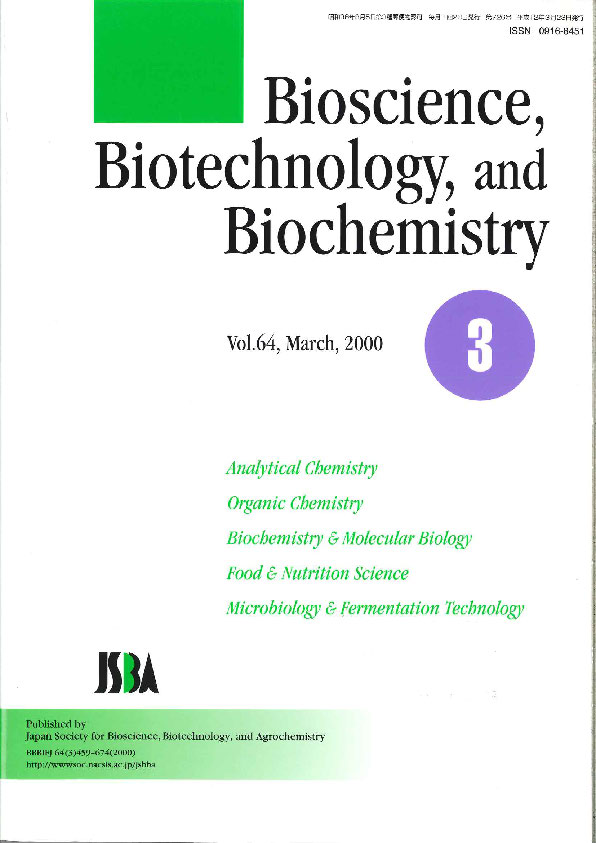Volume 64, Issue 3
Displaying 1-39 of 39 articles from this issue
- |<
- <
- 1
- >
- >|
Organic Chemistry Regular Papers
-
2000 Volume 64 Issue 3 Pages 530-538
Published: 2000
Released on J-STAGE: March 02, 2005
Download PDF (1059K) -
2000 Volume 64 Issue 3 Pages 539-549
Published: 2000
Released on J-STAGE: March 02, 2005
Download PDF (1356K)
Organic Chemistry Notes
-
2000 Volume 64 Issue 3 Pages 584-587
Published: 2000
Released on J-STAGE: March 02, 2005
Download PDF (734K) -
2000 Volume 64 Issue 3 Pages 600-602
Published: 2000
Released on J-STAGE: March 02, 2005
Download PDF (752K) -
2000 Volume 64 Issue 3 Pages 610-612
Published: 2000
Released on J-STAGE: March 02, 2005
Download PDF (588K) -
2000 Volume 64 Issue 3 Pages 620-622
Published: 2000
Released on J-STAGE: March 02, 2005
Download PDF (573K) -
2000 Volume 64 Issue 3 Pages 625-627
Published: 2000
Released on J-STAGE: March 02, 2005
Download PDF (524K) -
2000 Volume 64 Issue 3 Pages 647-651
Published: 2000
Released on J-STAGE: March 02, 2005
Download PDF (861K) -
2000 Volume 64 Issue 3 Pages 660-664
Published: 2000
Released on J-STAGE: March 02, 2005
Download PDF (1344K)
Biochemistry & Molecular Biology Regular Papers
-
2000 Volume 64 Issue 3 Pages 503-509
Published: 2000
Released on J-STAGE: March 02, 2005
Download PDF (958K) -
2000 Volume 64 Issue 3 Pages 510-515
Published: 2000
Released on J-STAGE: March 02, 2005
Download PDF (1194K) -
2000 Volume 64 Issue 3 Pages 523-529
Published: 2000
Released on J-STAGE: March 02, 2005
Download PDF (1479K) -
2000 Volume 64 Issue 3 Pages 562-568
Published: 2000
Released on J-STAGE: March 02, 2005
Download PDF (4542K) -
2000 Volume 64 Issue 3 Pages 569-576
Published: 2000
Released on J-STAGE: March 02, 2005
Download PDF (1513K) -
2000 Volume 64 Issue 3 Pages 577-583
Published: 2000
Released on J-STAGE: March 02, 2005
Download PDF (892K)
Biochemistry & Molecular Biology Notes
-
2000 Volume 64 Issue 3 Pages 592-595
Published: 2000
Released on J-STAGE: March 02, 2005
Download PDF (1733K) -
2000 Volume 64 Issue 3 Pages 603-605
Published: 2000
Released on J-STAGE: March 02, 2005
Download PDF (943K) -
2000 Volume 64 Issue 3 Pages 606-609
Published: 2000
Released on J-STAGE: March 02, 2005
Download PDF (849K) -
2000 Volume 64 Issue 3 Pages 623-624
Published: 2000
Released on J-STAGE: March 02, 2005
Download PDF (648K) -
2000 Volume 64 Issue 3 Pages 628-632
Published: 2000
Released on J-STAGE: March 02, 2005
Download PDF (1178K) -
2000 Volume 64 Issue 3 Pages 636-640
Published: 2000
Released on J-STAGE: March 02, 2005
Download PDF (1150K) -
2000 Volume 64 Issue 3 Pages 641-646
Published: 2000
Released on J-STAGE: March 02, 2005
Download PDF (1344K) -
2000 Volume 64 Issue 3 Pages 657-659
Published: 2000
Released on J-STAGE: March 02, 2005
Download PDF (571K)
Biochemistry & Molecular Biology Preliminary Communication
-
2000 Volume 64 Issue 3 Pages 670-673
Published: 2000
Released on J-STAGE: March 02, 2005
Download PDF (1773K)
Food & Nutrition Science Regular Papers
-
2000 Volume 64 Issue 3 Pages 466-475
Published: 2000
Released on J-STAGE: March 02, 2005
Download PDF (1298K) -
2000 Volume 64 Issue 3 Pages 476-483
Published: 2000
Released on J-STAGE: March 02, 2005
Download PDF (1439K) -
2000 Volume 64 Issue 3 Pages 516-522
Published: 2000
Released on J-STAGE: March 02, 2005
Download PDF (1279K) -
2000 Volume 64 Issue 3 Pages 550-554
Published: 2000
Released on J-STAGE: March 02, 2005
Download PDF (1243K) -
2000 Volume 64 Issue 3 Pages 555-561
Published: 2000
Released on J-STAGE: March 02, 2005
Download PDF (1319K)
Food & Nutrition Science Notes
-
2000 Volume 64 Issue 3 Pages 588-591
Published: 2000
Released on J-STAGE: March 02, 2005
Download PDF (980K) -
2000 Volume 64 Issue 3 Pages 613-616
Published: 2000
Released on J-STAGE: March 02, 2005
Download PDF (849K) -
2000 Volume 64 Issue 3 Pages 633-635
Published: 2000
Released on J-STAGE: March 02, 2005
Download PDF (969K)
Microbiology & Fermentation Technology Regular Papers
-
2000 Volume 64 Issue 3 Pages 459-465
Published: 2000
Released on J-STAGE: March 02, 2005
Download PDF (3968K) -
2000 Volume 64 Issue 3 Pages 484-491
Published: 2000
Released on J-STAGE: March 02, 2005
Download PDF (1260K) -
2000 Volume 64 Issue 3 Pages 492-502
Published: 2000
Released on J-STAGE: March 02, 2005
Download PDF (2333K)
Microbiology & Fermentation Technology Notes
-
2000 Volume 64 Issue 3 Pages 596-599
Published: 2000
Released on J-STAGE: March 02, 2005
Download PDF (1044K) -
2000 Volume 64 Issue 3 Pages 617-619
Published: 2000
Released on J-STAGE: March 02, 2005
Download PDF (678K) -
2000 Volume 64 Issue 3 Pages 652-656
Published: 2000
Released on J-STAGE: March 02, 2005
Download PDF (1428K) -
2000 Volume 64 Issue 3 Pages 665-669
Published: 2000
Released on J-STAGE: March 02, 2005
Download PDF (1436K)
- |<
- <
- 1
- >
- >|
